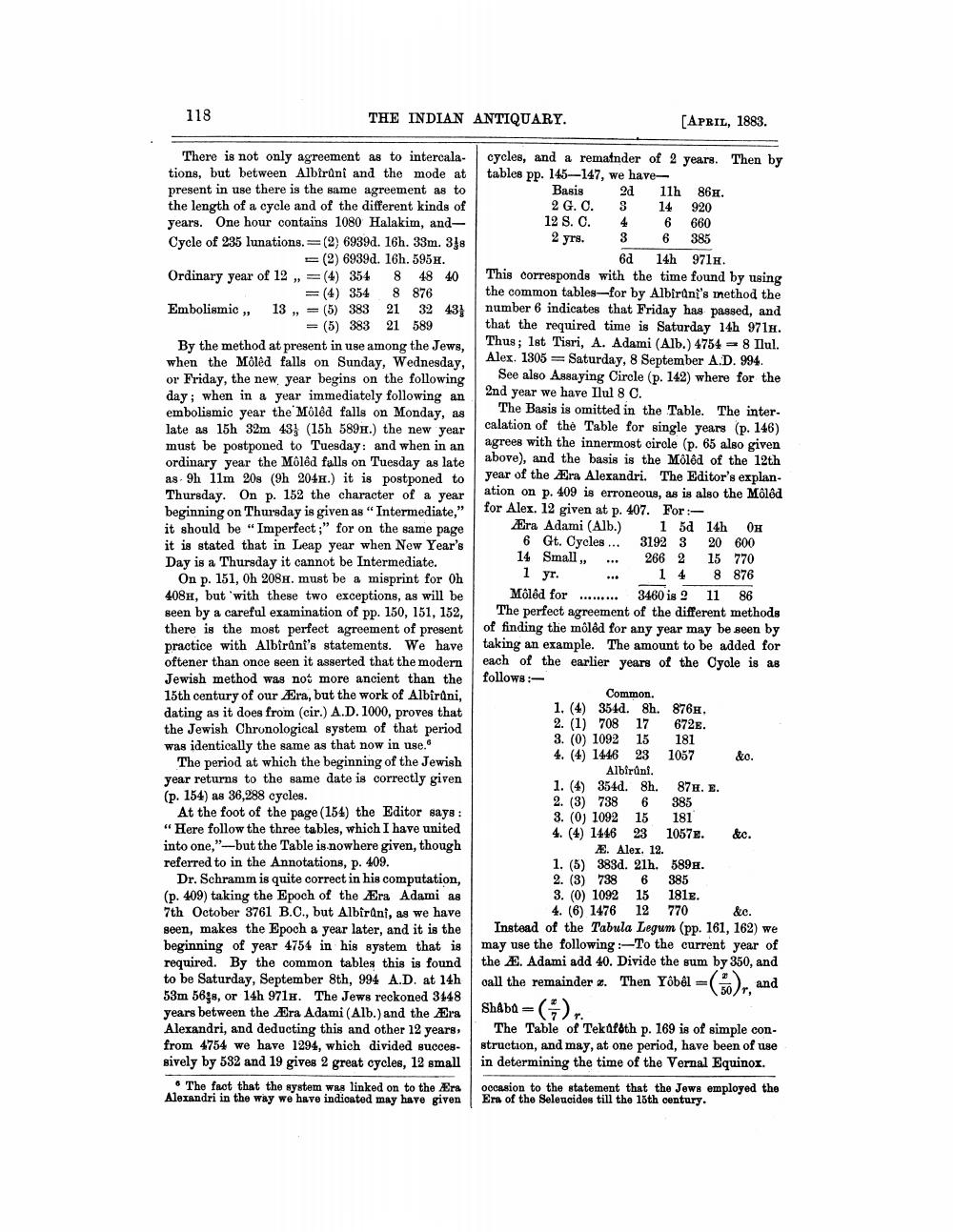________________
118
THE INDIAN ANTIQUARY.
[APRIL, 1883.
There is not only agreement as to intercalations, but between Albiruni and the mode at present in use there is the same agreement as to the length of a cycle and of the different kinds of years. One hour contains 1080 Halakim, andCycle of 235 lunations.=(2) 6939d. 16h. 33m. 318
= (2) 6939d. 16h. 595. Ordinary year of 12 ,, =(4) 354 8 48 40
=(4) 354 8 876 Embolismic , 13 ,, = (5) 383 21 32 43
= (5) 383 21 589 By the method at present in use among the Jews, when the Moled falls on Sunday, Wednesday, or Friday, the new year begins on the following day; when in a year immediately following an embolismic year the Molêd falls on Monday, as late as 15h 32m 43; (15h 589H.) the new year must be postponed to Tuesday: and when in an ordinary year the Molêd falls on Tuesday as late as 9h 11m 20s (9h 204H.) it is postponed to Thursday. On p. 152 the character of a year beginning on Thursday is given as "Intermediate," it should be "Imperfect;" for on the same page it is stated that in Leap year when New Year's Day is a Thursday it cannot be Intermediate.
On p. 151, Oh 2084. must be a misprint for Oh 408H, but with these two exceptions, as will be seen by a careful examination of pp. 150, 151, 152, there is the most perfect agreement of present practice with Albiruni's statements. We have oftener than once seen it asserted that the modern Jewish method was not more ancient than the 15th century of our Æra, but the work of Albiruni, dating as it does from (cir.) A.D. 1000, proves that the Jewish Chronological system of that period was identically the same as that now in use.
The period at which the beginning of the Jewish year returns to the same date is correctly given (p. 154) as 36,288 cycles.
At the foot of the page (154) the Editor says: "Here follow the three tables, which I have united into one,”—but the Table is nowhere given though referred to in the Annotations, p. 409.
Dr. Schramm is quite correct in his computation, (p. 409) taking the Epoch of the Æra Adami as 7th October 3761 B.C., but Albirani, as we have seen, makes the Epoch a year later, and it is the beginning of year 4754 in his system that is required. By the common tables this is found to be Saturday, September 8th, 994 A.D. at 14h 53m 5648, or 14h 971. The Jews reckoned 3448 years between the Æra Adami (Alb.) and the Æra Alexandri, and deducting this and other 12 years, from 4754 we have 1294, which divided successively by 532 and 19 gives 2 great cycles, 12 small
cycles, and a remainder of 2 years. Then by tables pp. 145-147. we have
Basis 2d 11h 86 . 2 G. O. S 14 920 12 S. O. 4 6 660 2 yrs. 3 6 385
6d 14h 9711. This corresponds with the time found by using the common tables-for by Albiruni's method the number 6 indicates that Friday has passed, and that the required time is Saturday 14h 9711. Thus; 1st Tisri, A. Adami (Alb.) 4754 8 Ilul. Alex. 1305 = Saturday, 8 September A.D. 994.
See also Assaying Circle (p. 142) where for the 2nd year we have Ilul 8 C.
The Basis is omitted in the Table. The inter. calation of the Table for single years (p. 146) agrees with the innermost circle (p. 65 also given above), and the basis is the Môlêd of the 12th year of the Ara Alexandri. The Editor's explanation on p. 409 is erroneous, as is also the Môlôd for Alex. 12 given at p. 407. For :
Era Adami (Alb.) 1 5d 14h OH
6 Gt. Cycles... 3192 3 20 600 14 Small, ... 266 2 15 770
1 yr. .. 1 4 8 876 Môlêd for ......... 3460 is 2 11 86 The perfect agreement of the different methods of finding the môlêd for any year may be seen by taking an example. The amount to be added for each of the earlier years of the Oyole is as follows:
Common. 1. (4) 3543. 8h. 876H. 2. (1) 708 17 672E. 3. (0) 1092 15 181 4. (4) 1446 23 1057
Albiruni. 1. (4) 354d. 8h. 87H. E. 2. (3) 7386 385 3. (O) 1092 15 181 4. (4) 1446 23 1057E.
&c. Æ. Alex. 12. 1. (5) 383d. 21h. 589. 2. (3) 738 6 385 3. (0) 1092 15 181E. 4. (6) 1476 12 770
&c. Instead of the Tabula Legum (pp. 161, 162) we may use the following :-To the current year of the Æ. Adami add 40. Divide the sum by 350, and call the remainder .. Then Yobel = ), and Shabd = 6).
The Table of Tekaleth p. 169 is of simple construction, and may, at one period, have been of use in determining the time of the Vernal Equinox. occasion to the statement that the Jews employed the Ers of the Seleucides till the 15th century.
The fact that the system was linked on to the Æra Alexandri in the way we have indicated may have given




